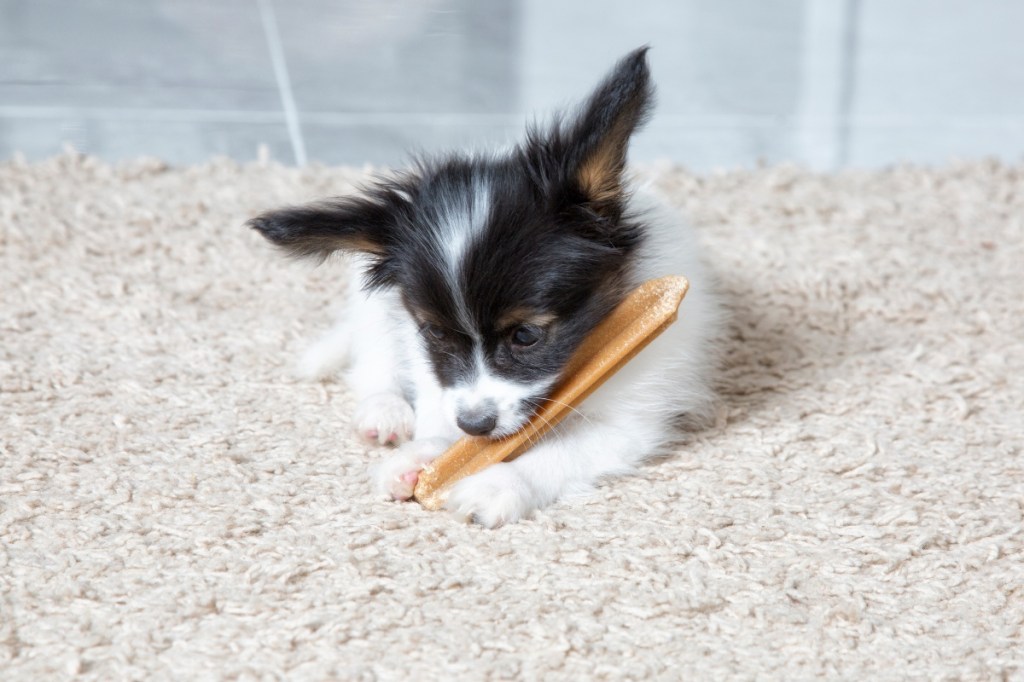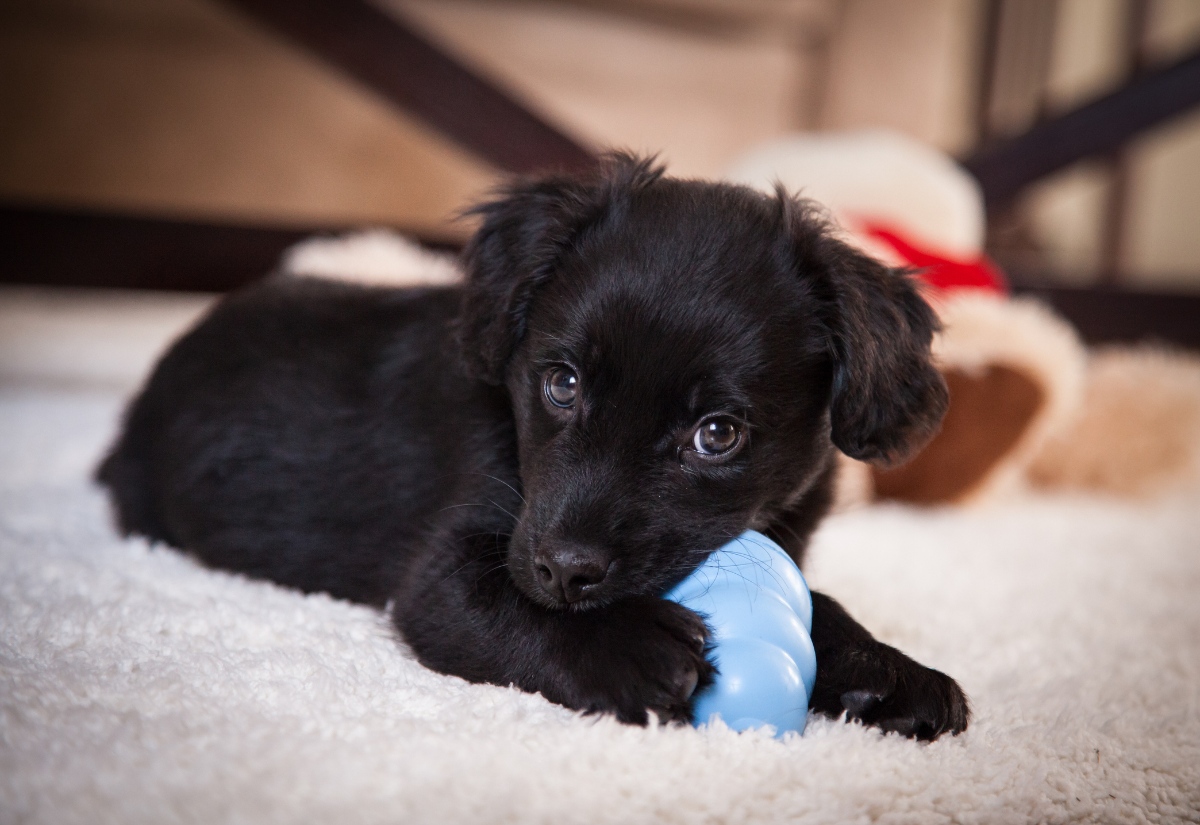Table of Contents
Dogs and puppies have a natural tendency to chew for a number of reasons, and sometimes, these chewing desires can lead to unwanted damage to our furniture, shoes, and other belongings. To create a harmonious home with your four-legged friend, it’s best to redirect them to an appropriate outlet rather than trying to curb chewing behaviors altogether.
Why do dogs chew?
Dogs may chew on items in their surroundings for a number of reasons; for example, teething puppies chew to relieve discomfort as their new teeth come in.
Consulting dog trainer Sarah-Anne Reed says, “For many dogs, chew toys are really important. Puppies need chew toys to keep them entertained, especially when teething. Most adult dogs have 42 teeth, and they all come in within a two-month period, when your puppy is between four and six months old. The right dog chew can help with gum inflammation and teeth cleaning, and offers an appropriate object to chew on, rather than the table leg.”
Other reasons dogs chew include:
- Dogs may chew due to boredom or to release excess energy.
- Chewing may be a reaction to anxiety or stress.
- Chewing can also be a way for dogs to keep themselves entertained or stimulated.
Benefits of chewing for dogs
Give your dog the freedom to chew as much as they want by providing various chew toy options. In addition to redirecting destructive habits, chew toys are beneficial to dogs and puppies for many reasons, including:
- Dental health: chewing can help reduce the buildup of plaque and tartar and also promotes healthy gums.
- Mental and physical stimulation: this activity is an easy way to help keep your dog busy and entertained.
- Stress relief: chewing appropriate toys is a safe outlet for your dog to relieve mild stress, such as adjusting to a new environment.
Chew toys that are safe for dogs
The safety of a chew toy depends on several factors, including your dog’s size, age, chewing habits, and any dietary restrictions or sensitivities. Here are some types of dog chews that are generally considered safe when used appropriately:

Kongs
These durable rubber toys can be stuffed with treats, kibble, or peanut butter to provide mental and physical stimulation. They are suitable for a wide range of dogs.
Nylon chew toys
High-quality nylon chew toys, such as those made by Nylabone, can be safe and long-lasting for many dogs. Choose an appropriate size and texture based on your dog’s needs.
Rubber treat dispensers
Toys like the Kong Wobbler or treat-dispensing balls can be safe and engaging for dogs, as they encourage play and problem-solving.
Edible dog chews
Edible dental chews
Some dental chews, like those recommended by veterinarians, can help with dental hygiene and are generally safe for dogs. Be sure to follow the manufacturer’s guidelines and choose chews appropriate for your dog’s size.
Bully sticks
These natural, single-ingredient chews are generally safe and appealing to many dogs, and they last a long time. However, always supervise your dog while they’re chewing and choose an appropriate size to prevent choking.
Pig ears
These are 100% cartilage and fully digestible. Chewing on these can also help clean your dog’s teeth and reduce gum inflammation.
Raw bones
Some dogs enjoy raw bones, like beef or bison marrow bones. These can help clean teeth and provide mental stimulation, but they should always be given under supervision to prevent splintering or other risks.
Frozen treats
Frozen treats like ice cubes or frozen stuffed Kongs can provide safe and enjoyable dog chewing experiences.
“If you know how your dog treats their toys, it’s easier to determine which chew toy is best for them. How big it needs to be in width, length, and strength. However, it’s never a good idea to leave your dog with a chew toy unattended. And, if your dog has started to tear pieces off, or the toy has become smaller in size, always remove it,” Reed says.
Dog-trainer chew toy recommendations
Sarah-Anne Reed recommends Natural Farm Pet, a brand that provides 100$ natural treats, chews and bones. Suggested products include bully sticks, braided collagen sticks, and pig ears.
She also recommends Goughnuts, a brand that makes nearly indestructible dog toys with a lifetime warranty, such as the heavy-duty rubber stick toy with various size options and the virtually indestructible ball.
Chews that can be dangerous for dogs
Use extreme caution or avoid altogether some dog chews due to safety concerns. Toys that require close supervision or that should be avoided include:
- Toys that are too small for your dog. Small toys work well for small dogs, but for large dog breeds, they can pose a choking hazard. Or, if accidentally swallowed, they may warrant a veterinary visit for emergency surgery.
- Soft, stuffed toys. Aggressive chewers can easily tear a soft toy apart, and they could ingest the stuffing or squeaker, leading to a trip to the vet.
- Antlers or any object that is too hard. These can cause tooth fractures or result in the wear and grinding down of your dog’s teeth.
- Tennis balls. Balls are great for playing fetch, but if your dog enjoys sitting down to chew on a tennis ball, it’s best to find a new chew option. Tennis balls can be abrasive to a dog’s teeth, wearing them down over time.
- Rawhide chews. Many dogs find these delicious and irresistible, but they require close supervision. Some dogs chew off large chunks and try to swallow them, posing a risk of choking or digestive blockage.
- Cooked poultry bones. Never give cooked poultry bones to your dog. Though they taste and smell delicious for your pup, these bones splinter easily and can cause choking and internal injuries.
Be sure to supervise your dog when offering them a new chew toy to ensure it’s safe for them and their chewing style.








